Luis Acosta Striped Guitar
Over the years I've done quite a bit of research on the incredible family of Guadalupe Acosta of San Antonio Texas. I've written about how they made Lydia Mendoza's 12 string, as well as Lonnie Johnson's. I've had a few Acostas come through the shop in that time. I restored a marvelous checkered guitar that was made by Miguel Acosta. Most fortunately I have gotten to know the Acosta family who has done a fantastic job of preserving their family's legacy. I am grateful to them for the openness and generosity they have shown me. I recently completed the restoration of a guitar that was built by Luis Acosta around 1940. Luis had made the guitar for himself, as a showcase of his work as a luthier.
Luis was the second son of Guadalupe Acosta and Felicia Oldiveros, born in Lagos de Moreno, Jalisco Mexico, on May 4th, 1906. The Acosta family worked as luthiers in Lagos de Moreno, but due to the turmoil of the Mexican Revolution, Guadalupe moved his family north, first to Nuevo Laredo, Mexico, and then to San Antonio, Texas. In 1920 he opened the Acosta Music Company, with his sons working alongside him. The profound influence that the Acosta Music Company had on the Tejano and Mexican music of South Texas is neither understood nor fully appreciated at this time. Their importance cannot be overstated as they were the first established stringed instrument manufacturers in the region. They also sold sheet music and records in their shop, and worked with record companies as A&R men in their hunt for talent.
While Luis is known for his work with record companies, and as manager of the store in later years, he was not known for his abilities as a guitar maker. This guitar is a testament to his skill and patience. The guitar is a 000 sized six string with a 26" scale. It is very lightly fan braced and was built for steel strings. He used alternating 1/8" wide strips of light cotttonwood and dark walnut, laid out in a striped pattern for the back, sides and neck of the guitar. This type of pattern is somewhat ubiquitous in a shop that makes its own purlfings and rope bindings. It is the starting point for making such items and there are usually pieces of the raw blocks laying around a shop. The guitar is a play on the striped material and Luis was extremely clever with his layout of the pattern, using it as a large herringbone on the back of the guitar, and as stripes on the sides and neck. He also used a striped pattern for the rosette and edge purfling, rather than the more typical herringbone or diagonal checker. It is fantastic design at work.

Luis was photographed with the guitar in 1940, for the local newspaper, The San Antonio Light. The caption for the photo read ''Luis Acosta makes his guitar the hard way . This Instrument contains 4100 small pieces of wood.'' The article goes on to say '...Acosta, a San Antonio instrument manufacturer, spent six hard weeks fitting the tiny pieces...into a well-toned instrument. He didn't make it to sell; he just make it for the heck of it. Woods include black walnut, cottonwood, spruce and mahogany.''
Luis Acosta never married and after he died in 1975 the guitar bounced around and fell into disrepair. At a certain point his nephew Mike Acosta, a talented guitar repairman, found the guitar and brought it to his shop. Mike held onto the guitar as a keepsake, thinking it was too far gone and not worth repairing. Much of the striped laminate had come unglued from the substrate. A few pieces were missing. Worst of all the the neck had come unglued from the stacked heel, cracking the sides and taking a large portion of the top with it . Worse still the neck, fingerboard and portion of the top had gone missing and were nowhere to be found. When I visited him in 2017, Mike said he wanted to give me the striped guitar, along with the checkered guitar as a token of gratitude for the research I had done on his family and the work I did on the Lydia Mendoza 12 string. I told him that I was honored but could not accept the guitars. I made him a counter offer that I would prefer to restore the guitars and return them to his family. Mike may have seen it as a fool's errand, but he agreed and bought me some BBQ instead. We had a great meal, one I will remember forever, at Rudy's, a San Antonio institution. Afterward Mike shipped the guitars to my shop.
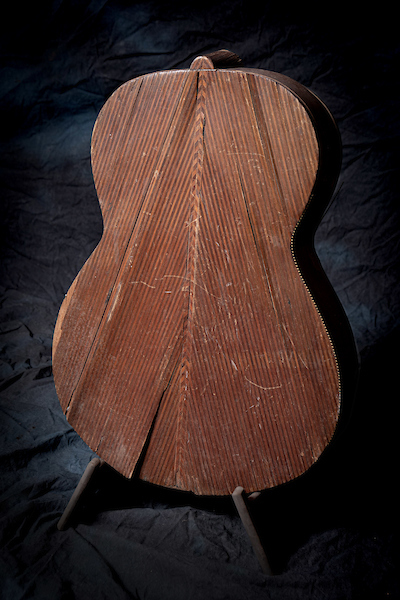
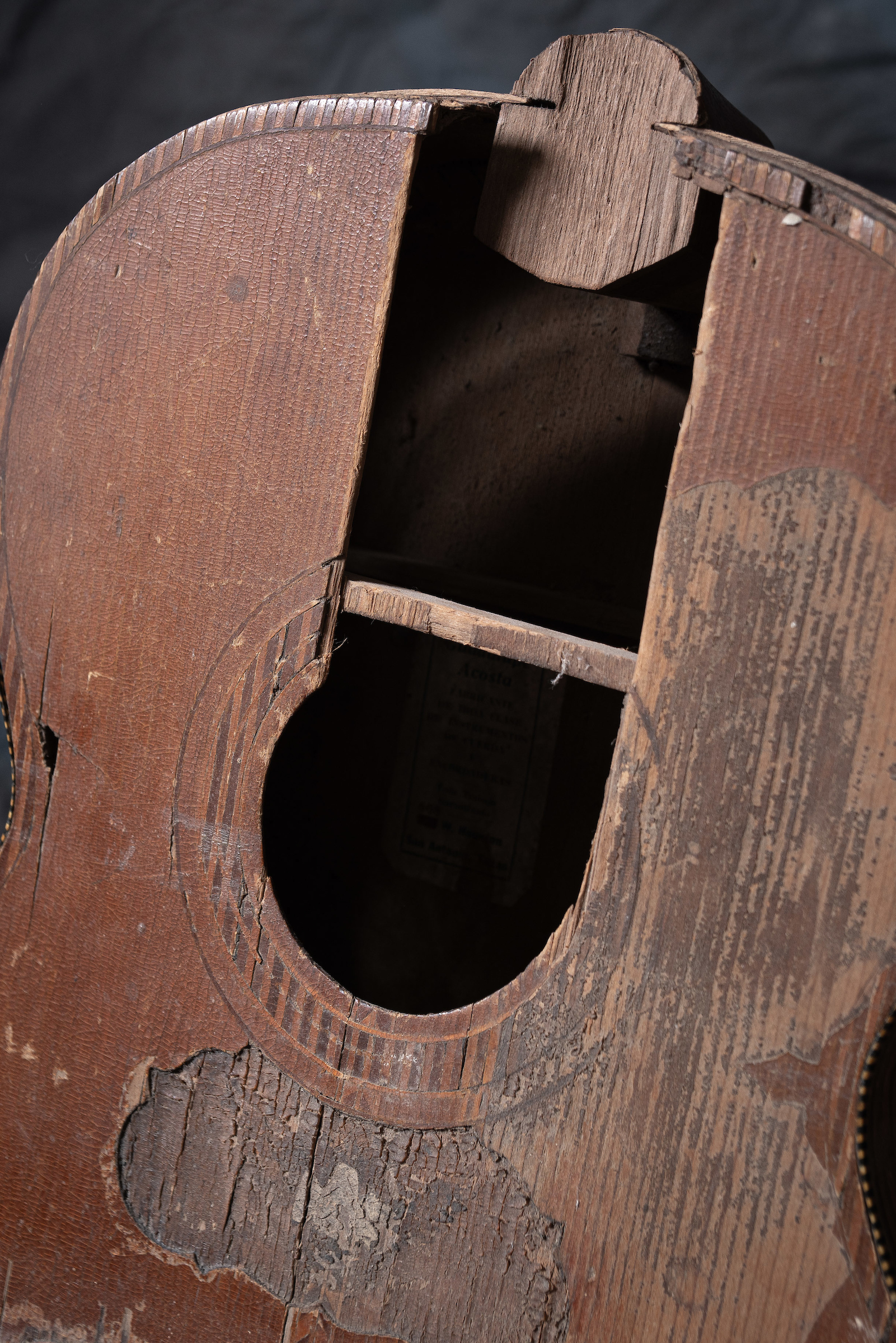
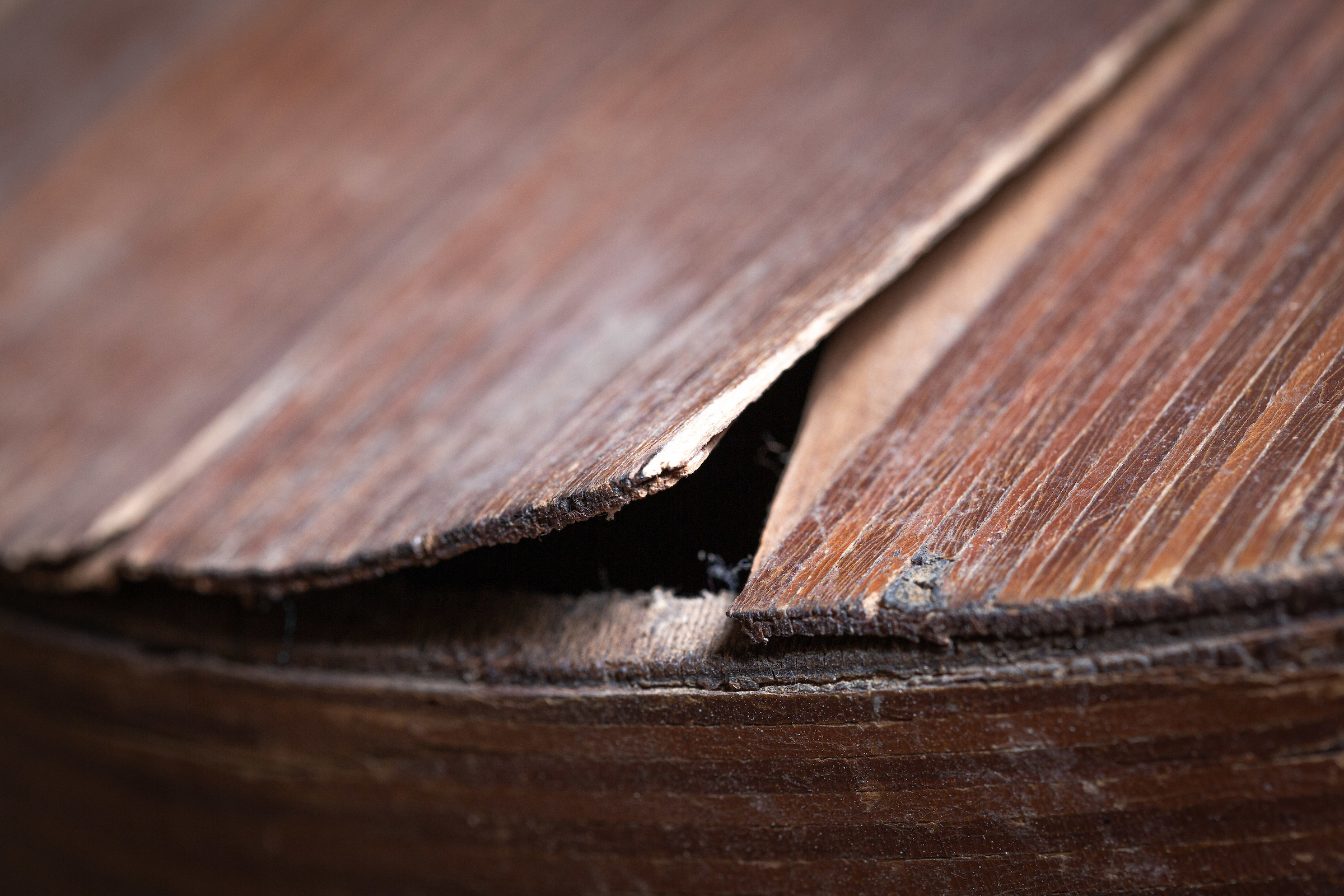
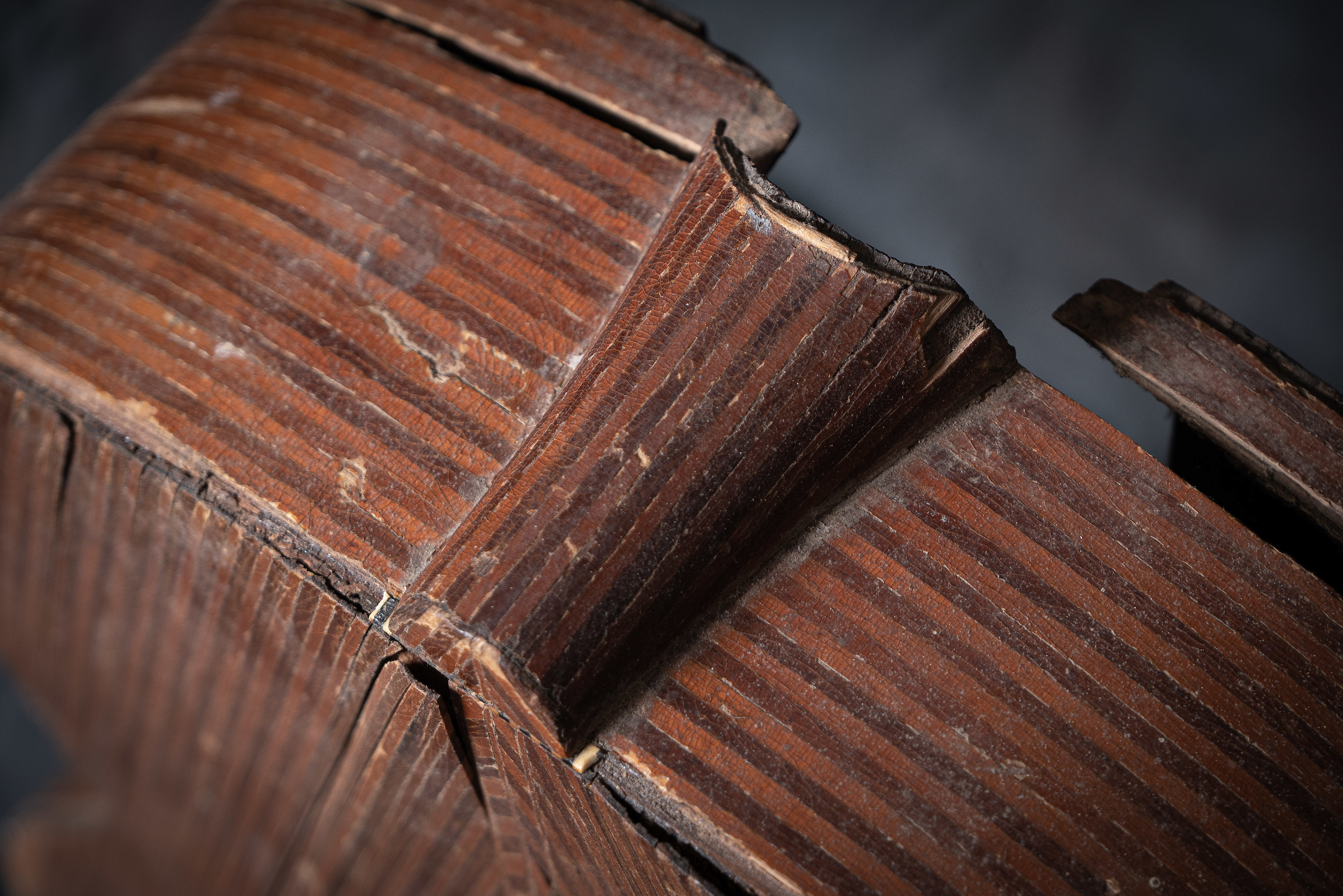
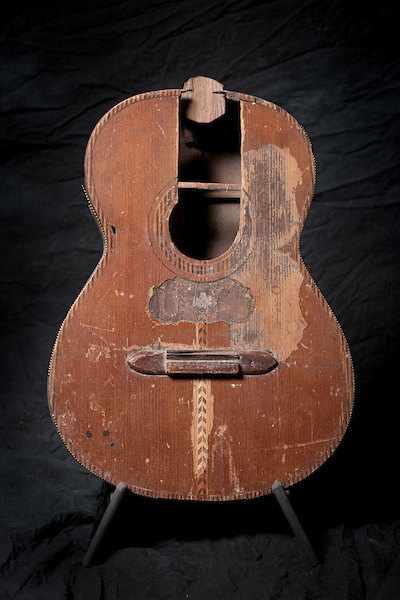
Once the guitars were at my shop I started to think about how to restore them. Both guitars were in horrible condition and were extremely fragile. It seemed like each time I picked one up to look at it or move it around the shop, it would shed a piece or two. In reality, they were both on the verve of turning back into dust. Nevertheless, I could see through their condition and missing pieces and envision what they were and what they could become. It took me quite a while to work out a strategy for fixing them, and I also needed an ample window of time in which to accomplish the work. The checkered guitar was first because it was the most intact. If you haven't read about that you should check out the article I wrote about it. Click the photo of the guitar on the right for a link.
I finished the checkered guitar last year and was able to return it to Mike in San Antonio. Sadly Mike Acosta passed away on January 5th, 2021. I was incredibly sad to hear the news. I thought about him and his family a lot during that time, and for me it meant that I needed to get to work on the striped guitar. I had mulled over a strategy for a couple years and it was time I started piecing it back together. Though nearly half the guitar was missing, there was a large format photo from the San Antonio Light, which gave me clues as to what had been there.
Obviously, if I wanted to get the guitar playing again I was going to have to make a neck. The original neck had a scarf joint at the headstock and a stacked heel, meaning several pieces of wood were glued to each other to make up the material for the heel. Slots were cut on either side of the heel into which the sides of the guitar were inserted. This arrangement is called a Spanish heel and it is the traditional way that guitars are made throughout Mexico and the rest of Latin America. Though the shaft of the neck was gone, the heel remained, with the sides glued into it. The portion of the sides that were glued to the shaft of the neck had come loose from the neck, and also cracked about 10" down each side. I wanted to keep as much of the original guitar as possible, and I wanted to reuse the heel as it was a work of art on its own. The first order of business was to extract the heel from the back and sides of the guitar. Tricky business.

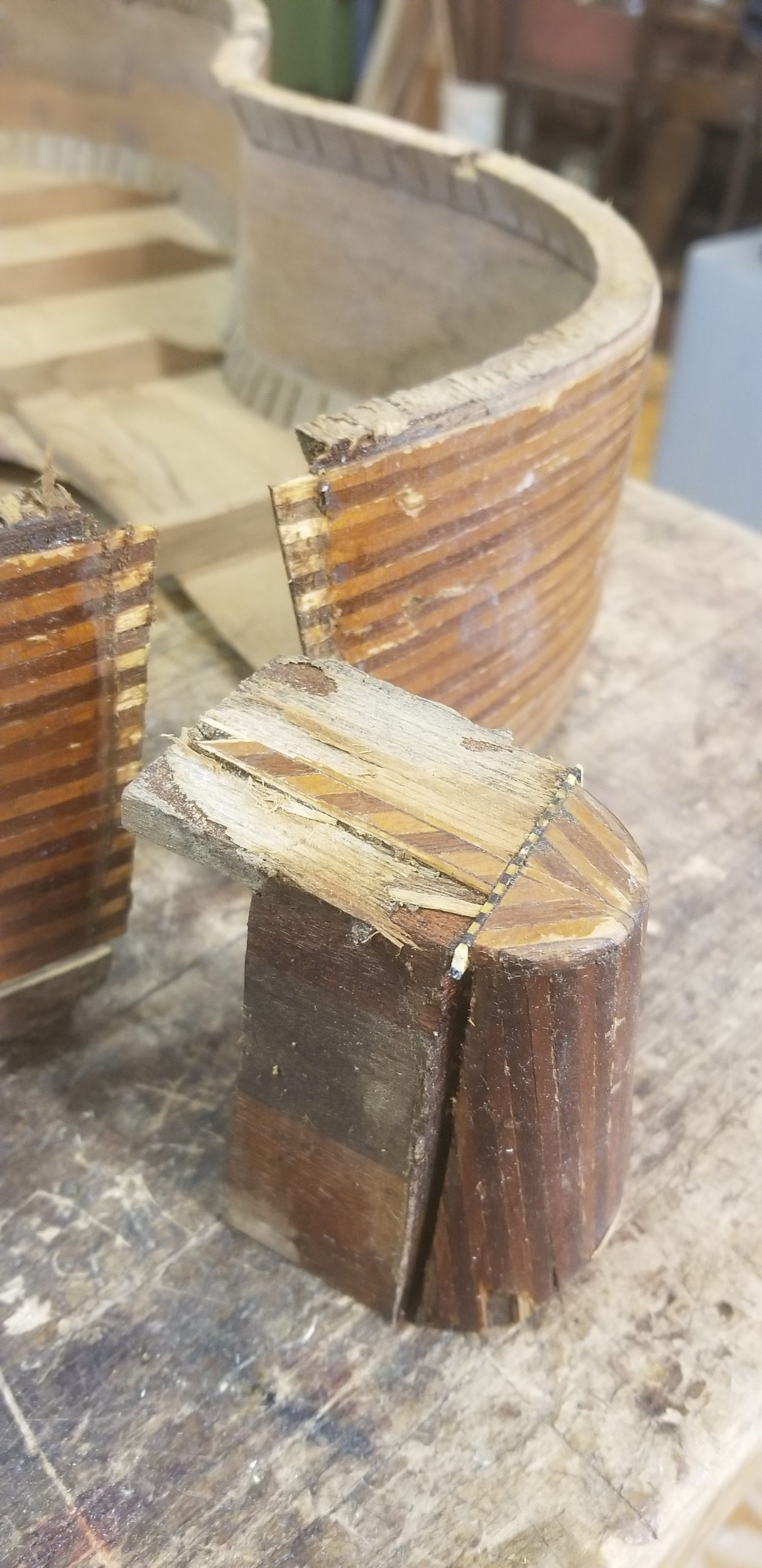
After I had removed the back and extracted the heel from the sides I was able to realign the cracked sides and glue them back together. I also started the process of reattaching the herringbone veneer back to the spruce substrate of the back. I repaired multiple cracks in the back, top and sides of the guitar, reinforcing them with either linen or wooden cleats. For the neck, I first made a scarf joint for the headstock, then I curved the shaft of the neck and matched it to the heel. After gluing the new shaft to the old heel, I decided to reinforce the joint with a dowel. I turned a 1/2" mahogany dowel on the lathe and glued it in with hot hide glue. I then covered the backside of the neck with veneer. One interesting thing I noticed from the photos, the guitar appeared to have a solid peghead, but it also had side mounted tuners, meaning that Luis had slotted the headstock, but covered up the backs of the slots with the striped veneer. I followed suit. I was able to match the profile of the headstock with another Acosta that I have in the shop.
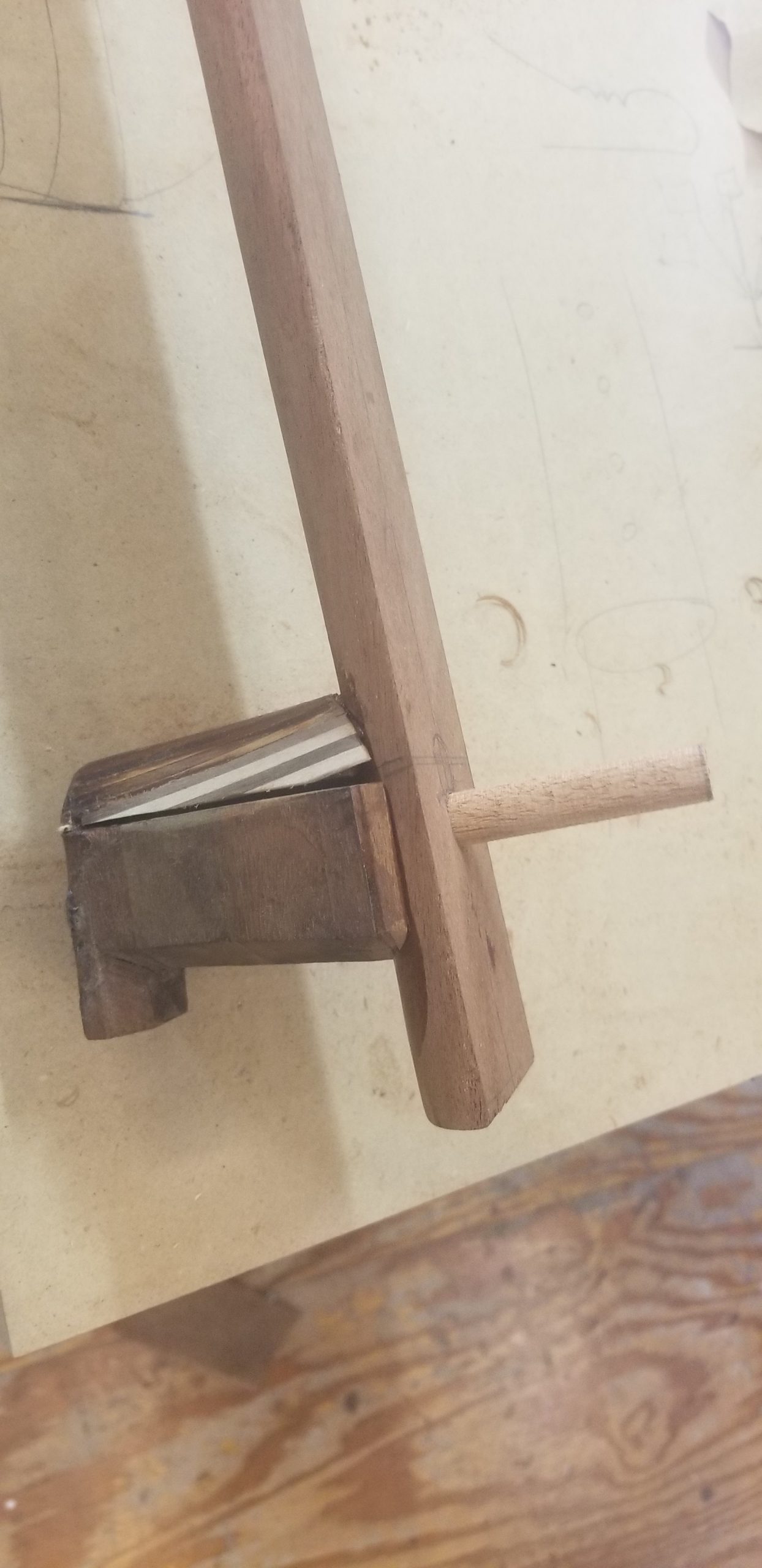
Once I had the veneer on the neck I started the process of fitting the neck to the body of the guitar. I cut new slots into the neck to fit the sides, and glued the sides into the slots. I then could start working on the missing portion of the top. I fit a piece of spruce that matched the old top and then cut out the missing portion of the rosette. I used the same veneer I had made for the neck for the rosette and for the missing purfling around the edge of the guitar. Next I fit a new pickguard into the void where the old one had been. Once all the work was done on the top I glued the back onto the guitar. I then added the checkered celluloid binding. There was enough of the old stuff left to use for the majority of the top. I was able to source some new material for the back (Thanks to Dale Fairbanks for the tip on the source). Once the binding was on I made a new walnut fingerboard and bridge. Because the old finish was so dirty, damaged and heavily oxidized, obscuring the details of the guitar, I opted to strip it and refinish the guitar with new varnish. I matched the finish on the new portions of the work to the old.
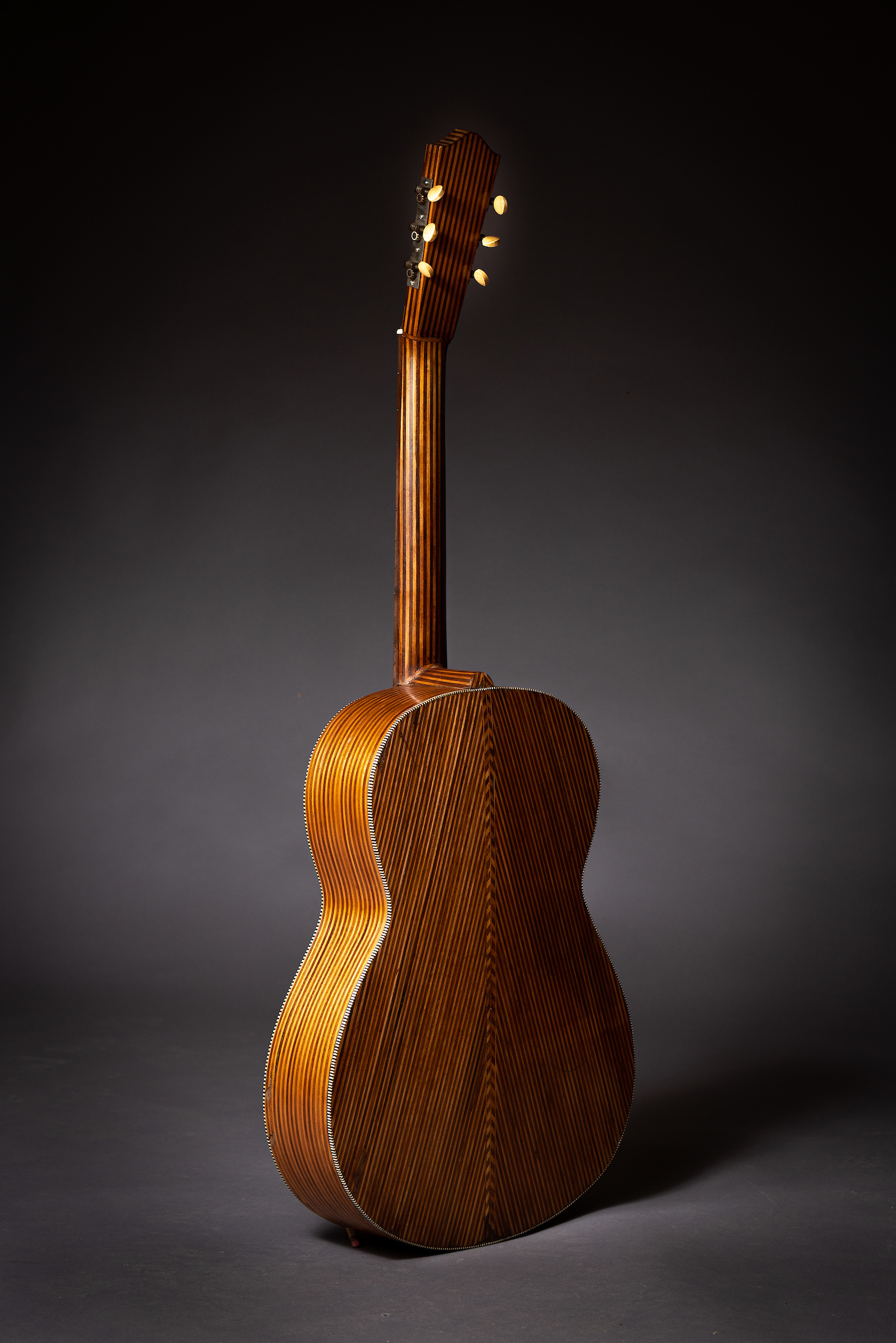
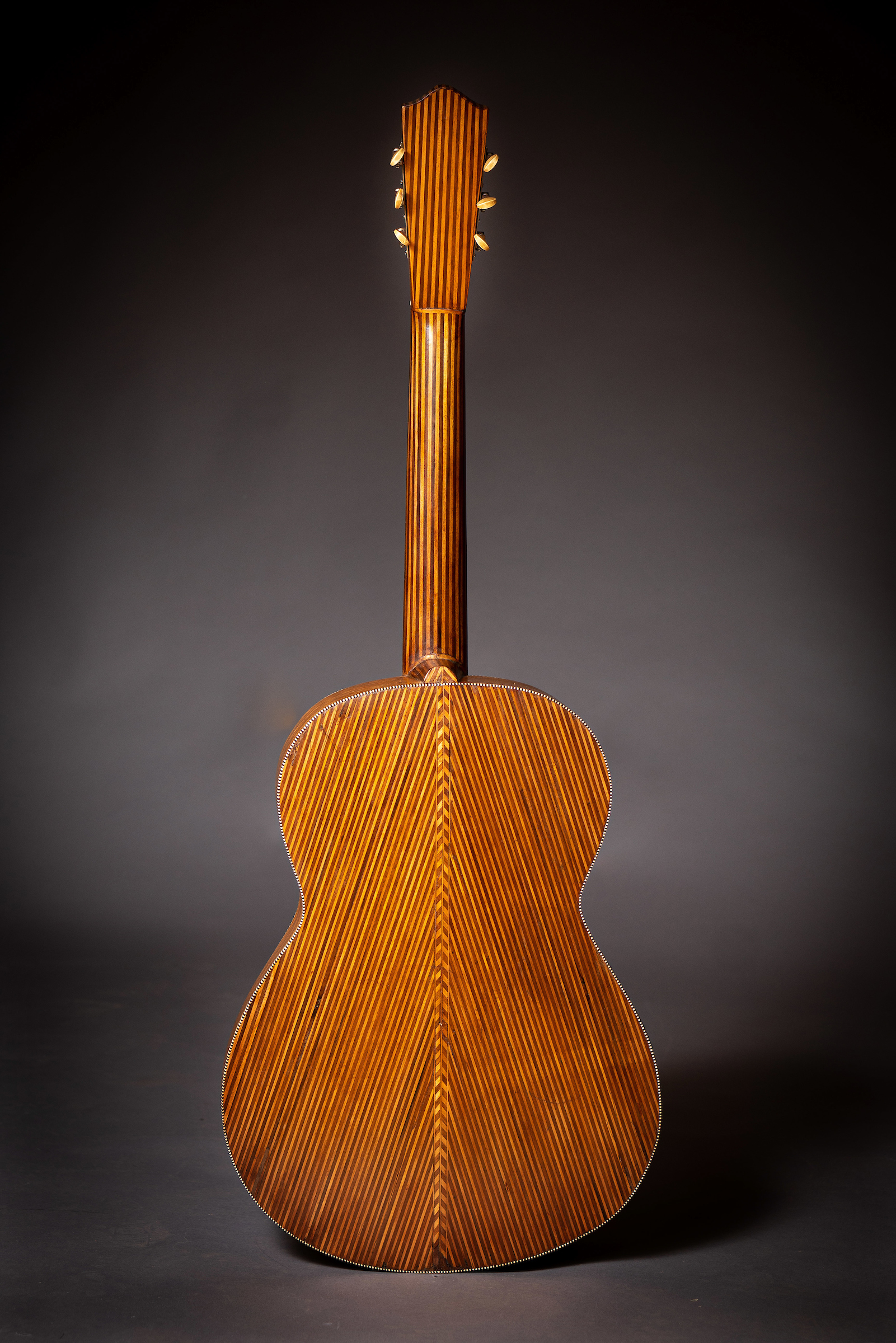
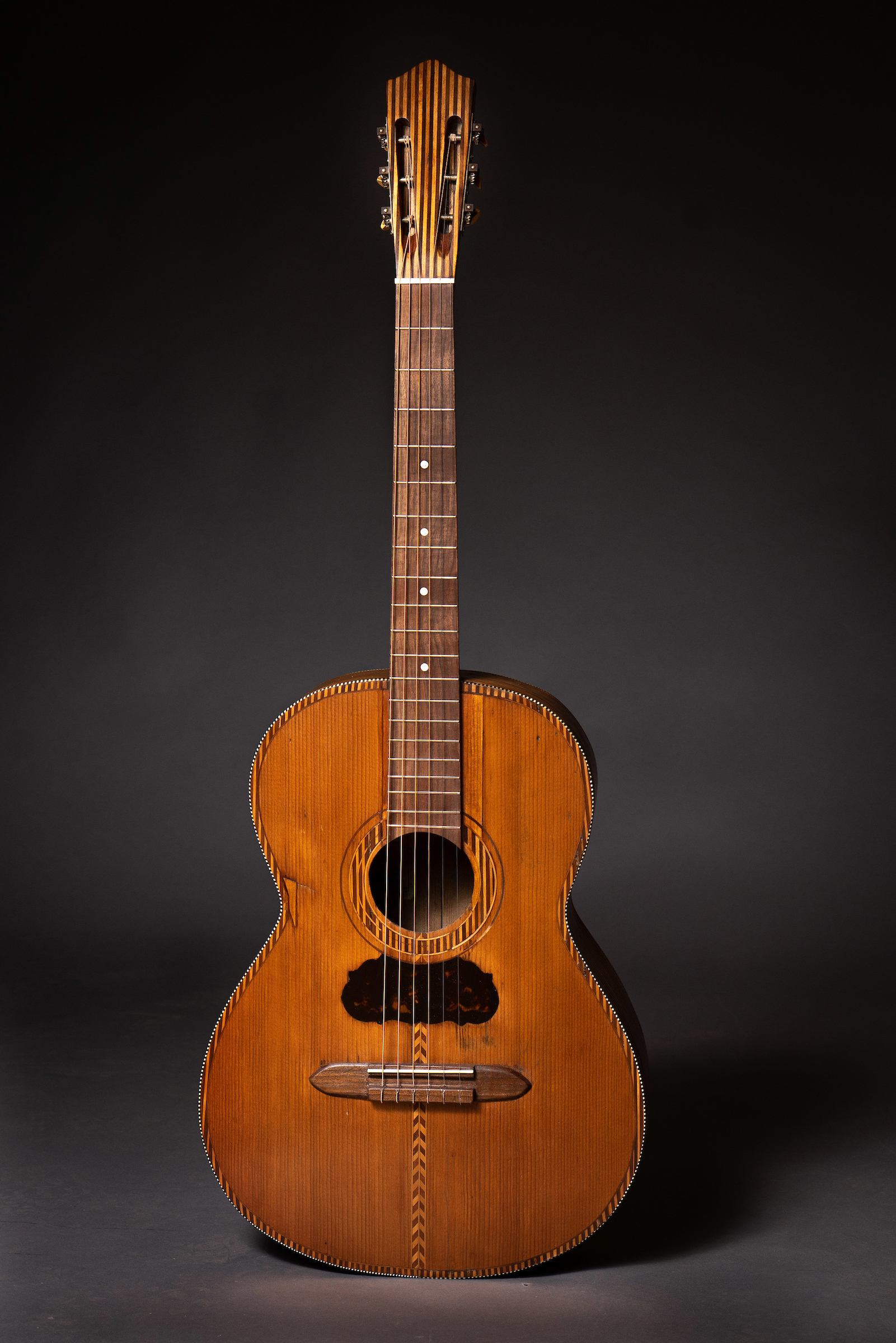
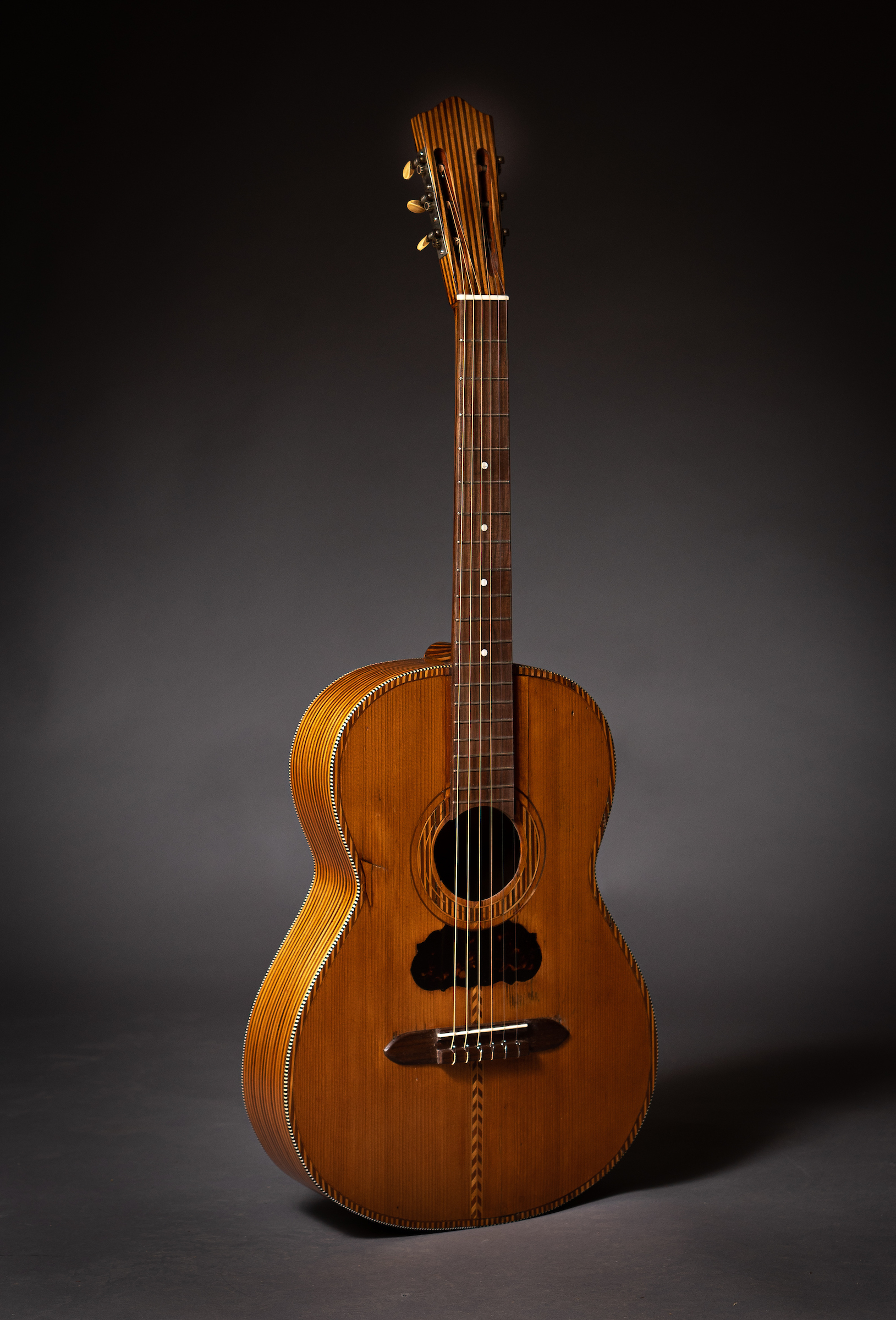
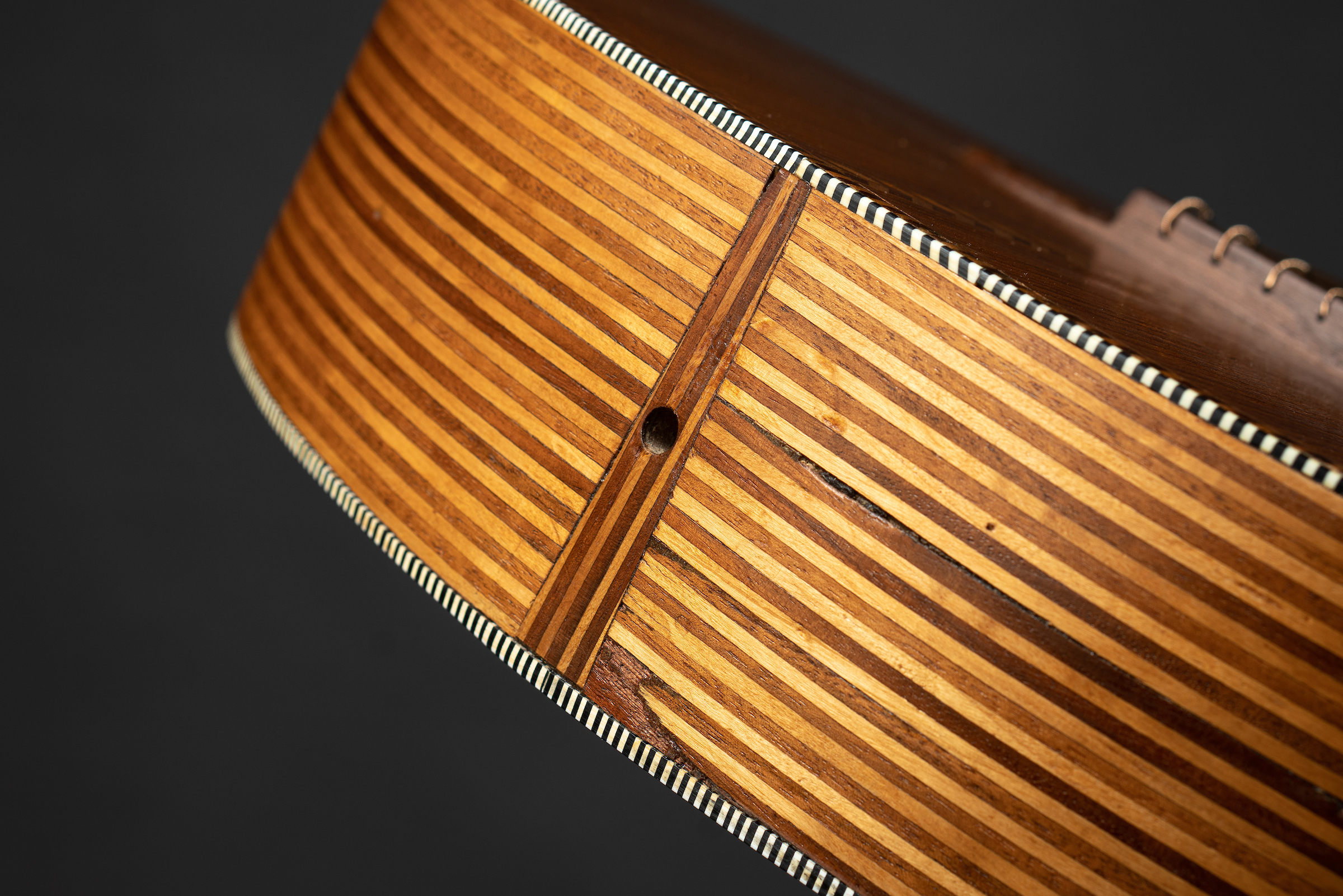
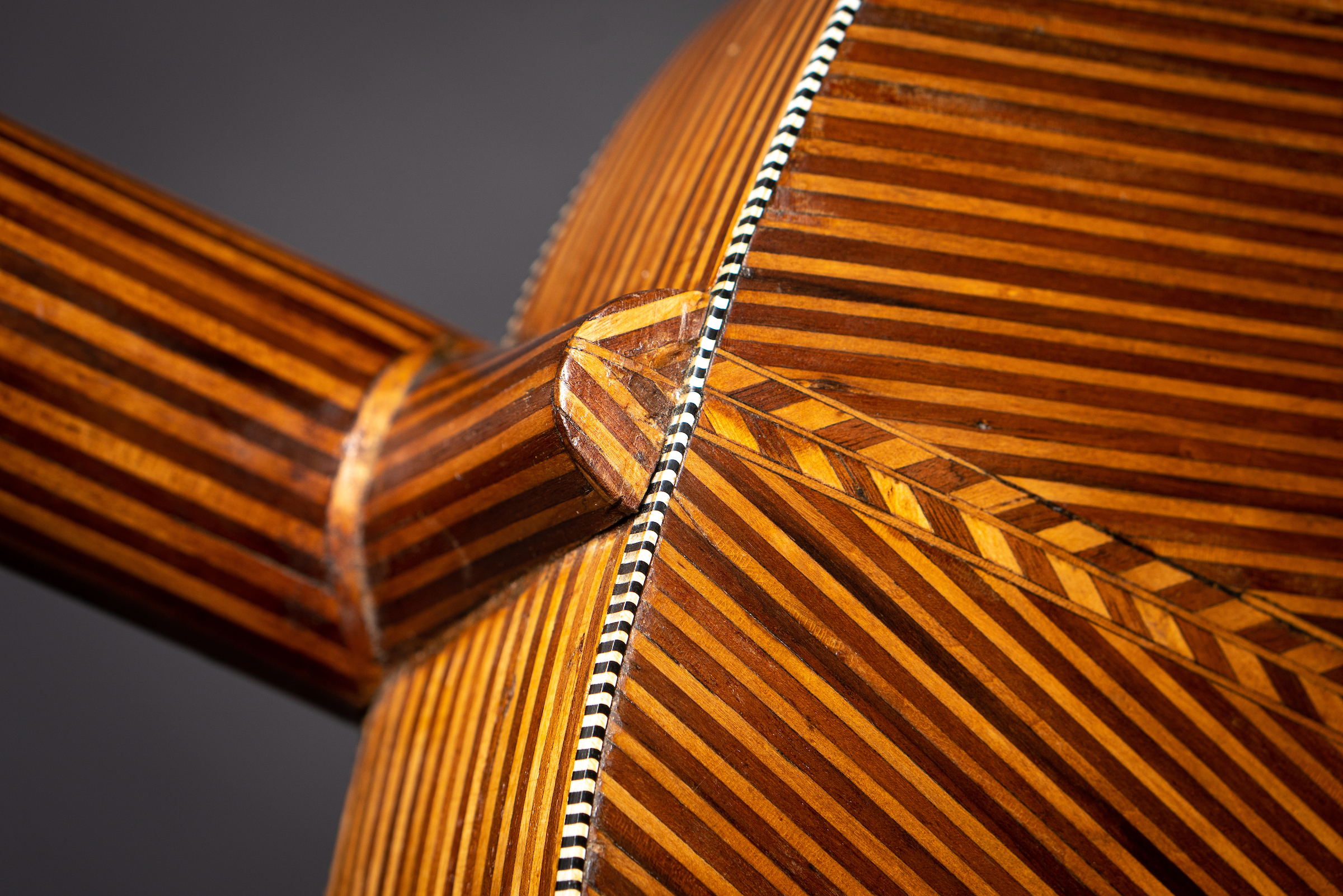

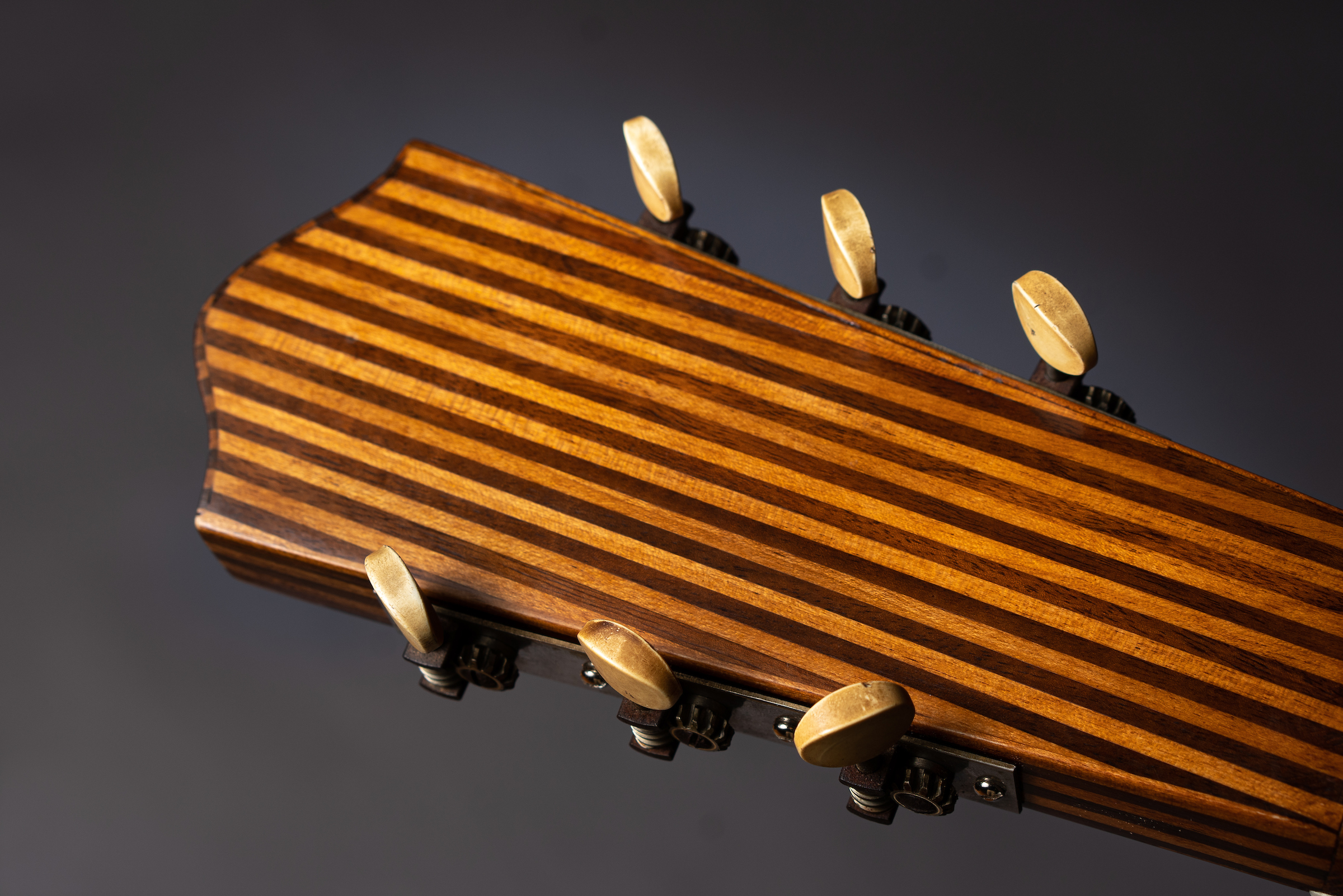
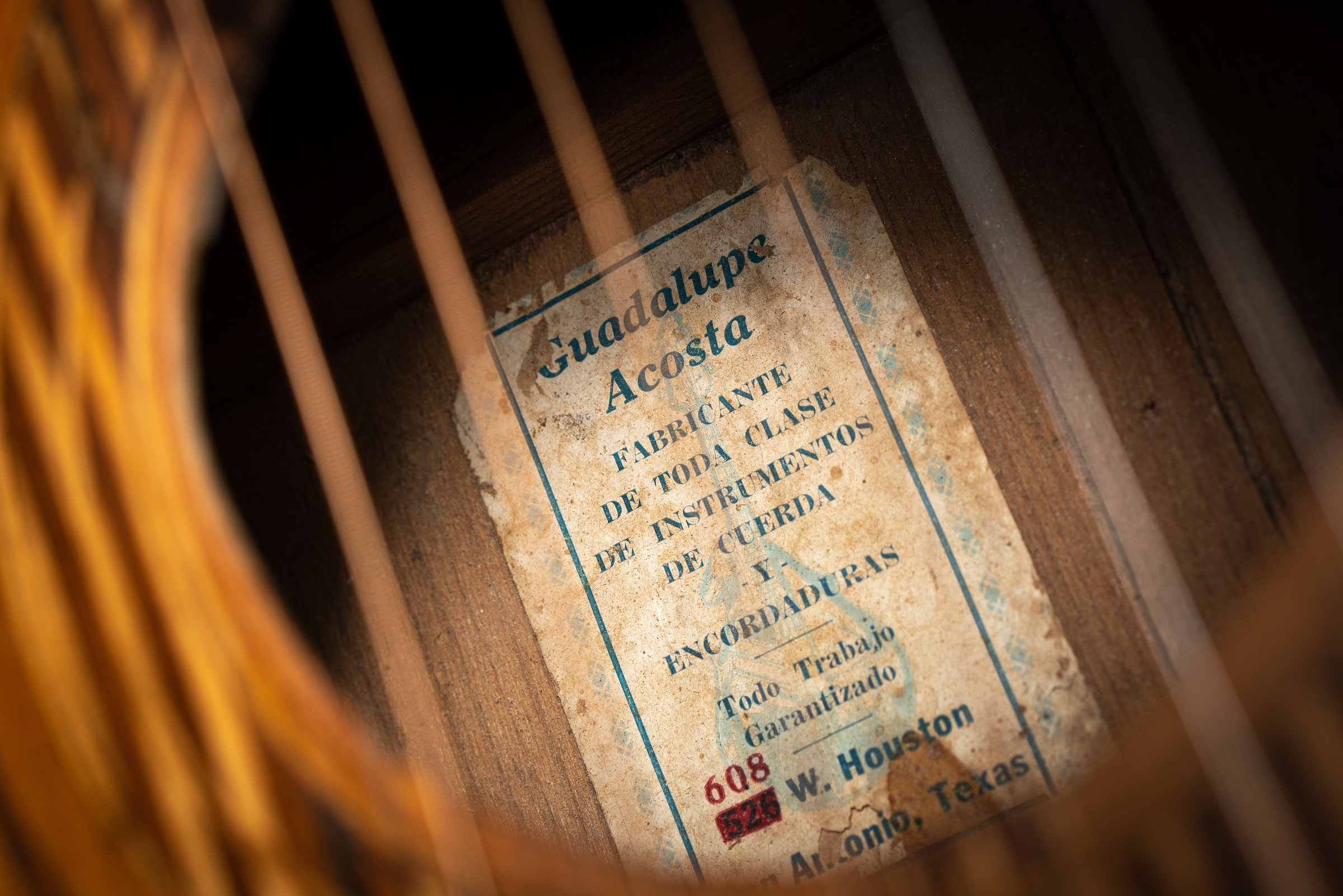
A lot of work went into the restoration of this guitar and the checkered guitar. Miguel Acosta was Luis' younger brother and I like to think that he built the checkered guitar (also for himself) as counter to Luis' striped guitar. If it was not a intentional reply, it was certainly inspired by the elder brother's work. When Mike Acosta originally showed me the two guitars, in their dismal condition, I could see through it all to the wonder that once was. It's part of my optimistic self. My mom would say that I was the type of kid who would see a pile of shit and say "There's a pony in there somewhere!" Both of these guitars are spectacular works made by excellent luthiers who were among the best of their time. That the Acostas have remained relatively unknown to the guitar world at large, and also to the worlds of Texas and Tejano music is a total mystery to me. Part of the reason I felt driven to return these guitars to their former glory is so that those worlds might take notice. I'm not as optimistic on that front. Nevertheless, working with the Acosta family on all of these projects has brought me great joy and I'm happy and proud that the guitar will return home and be appreciated.

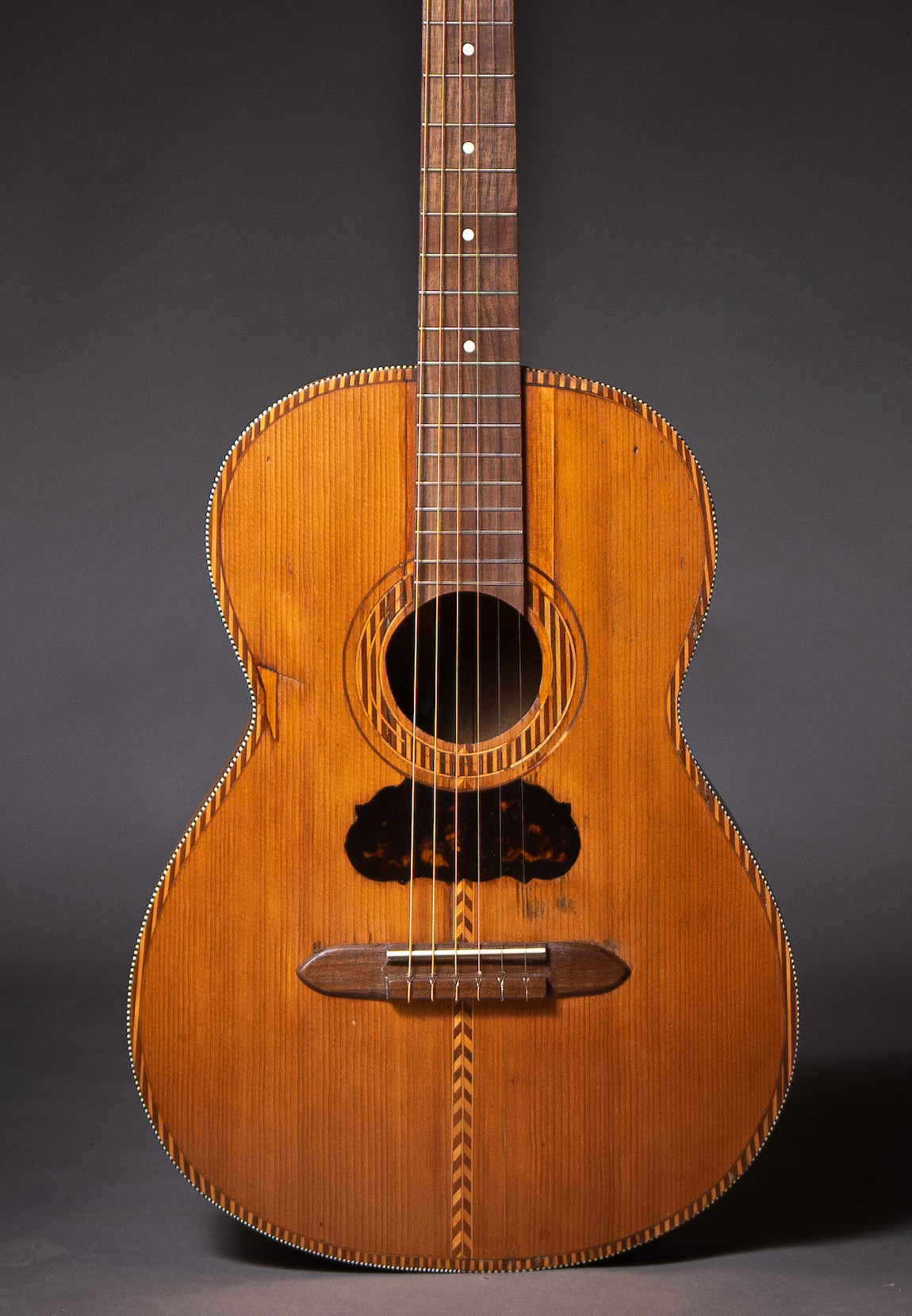

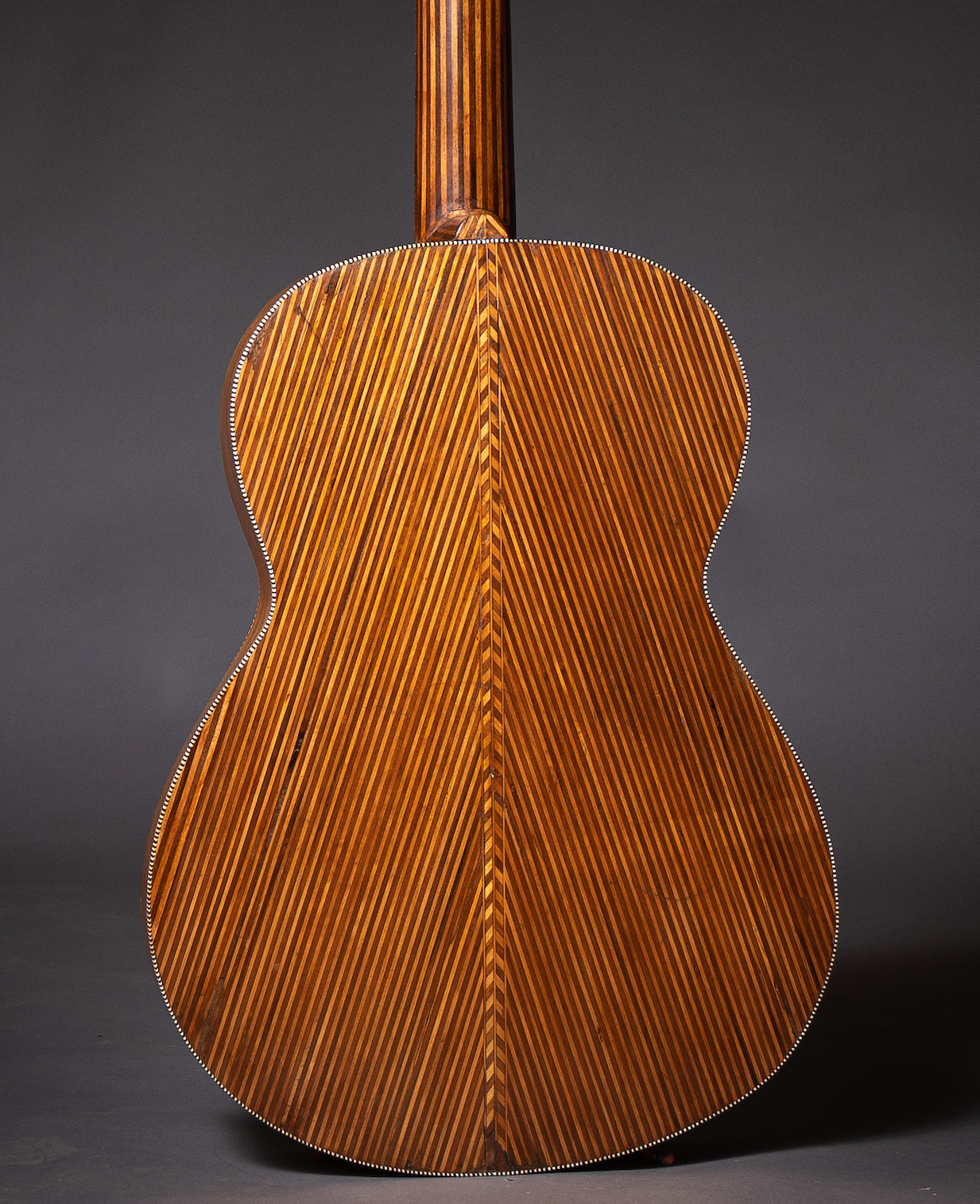
A huge thank you to Michael Acosta for his assistance and willingness to work with me. Also thanks to Kevin Ramirez for sharing his stories and memories of Miguel, and recordings of Sylvia and Miguel. Not to mention the neck that he and his father salvaged from Miguel's shop.Though it seemed heaven sent, I'm sorry I wasn't able to use it. A hearty thank you to my good friend John Maniaci, who took both before and after photos, and who, after seeing the original photo of Miguel with the striped guitar told me, "Go get a white shirt and a tie," and put me up to making our own version of Luis' photo. I'm sorry I couldn't find a vest, and that I'm 15 years older, a foot taller and 50lbs heavier than Miguel. The guitar though looks good.
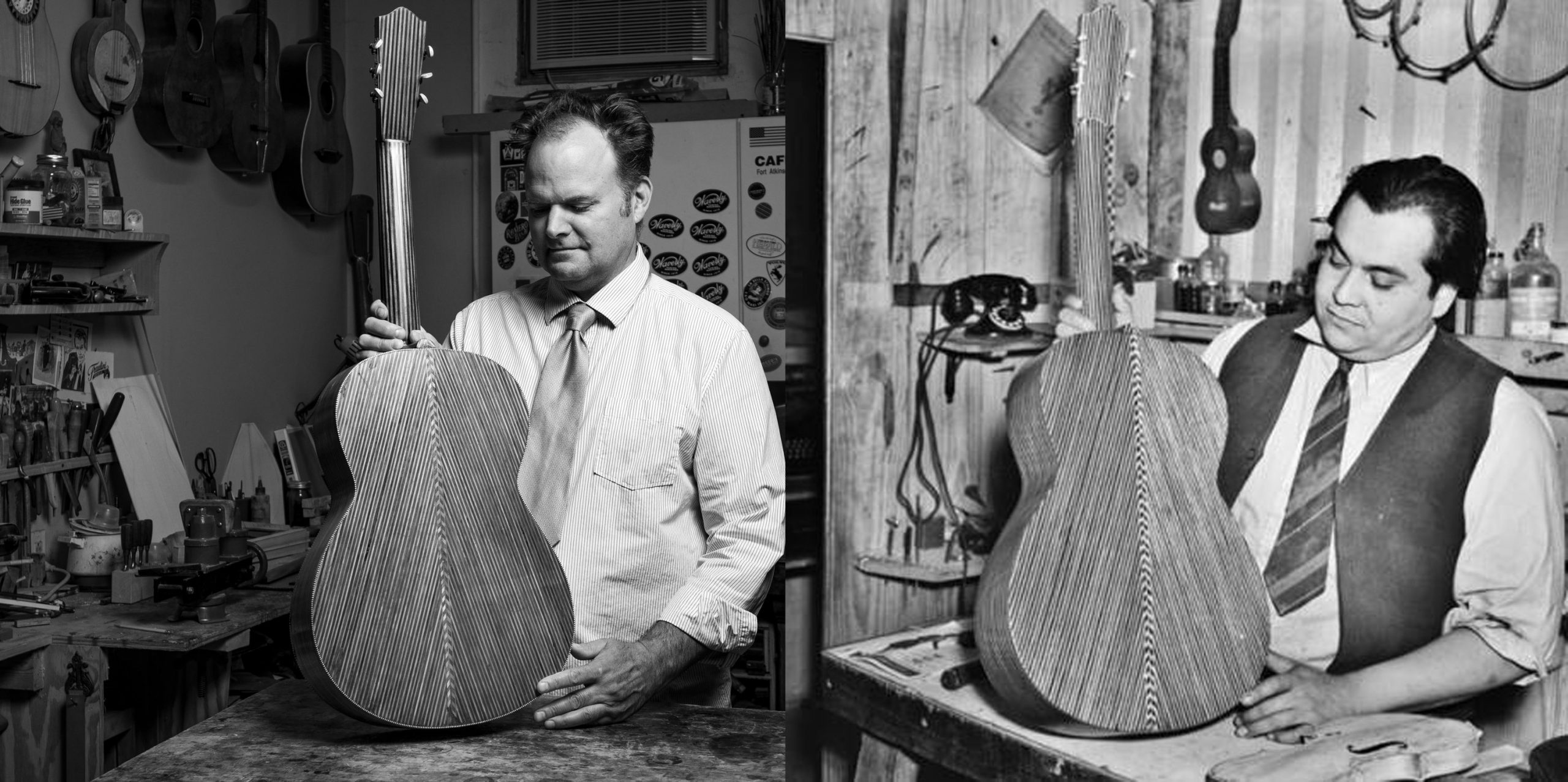
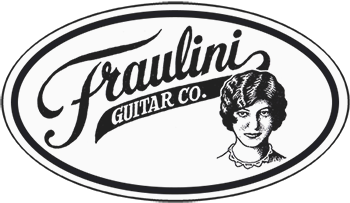
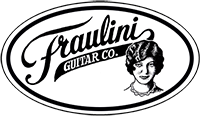

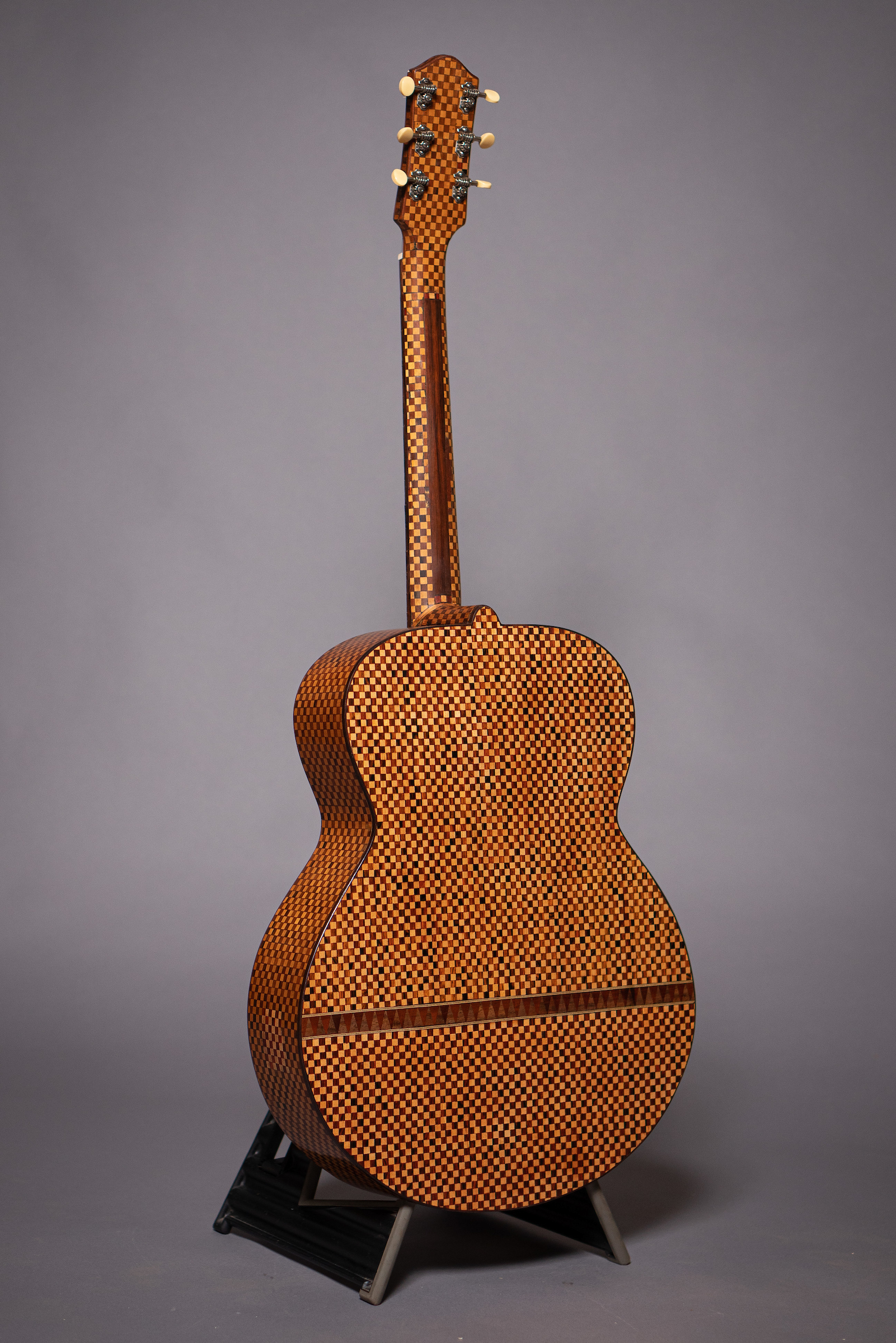
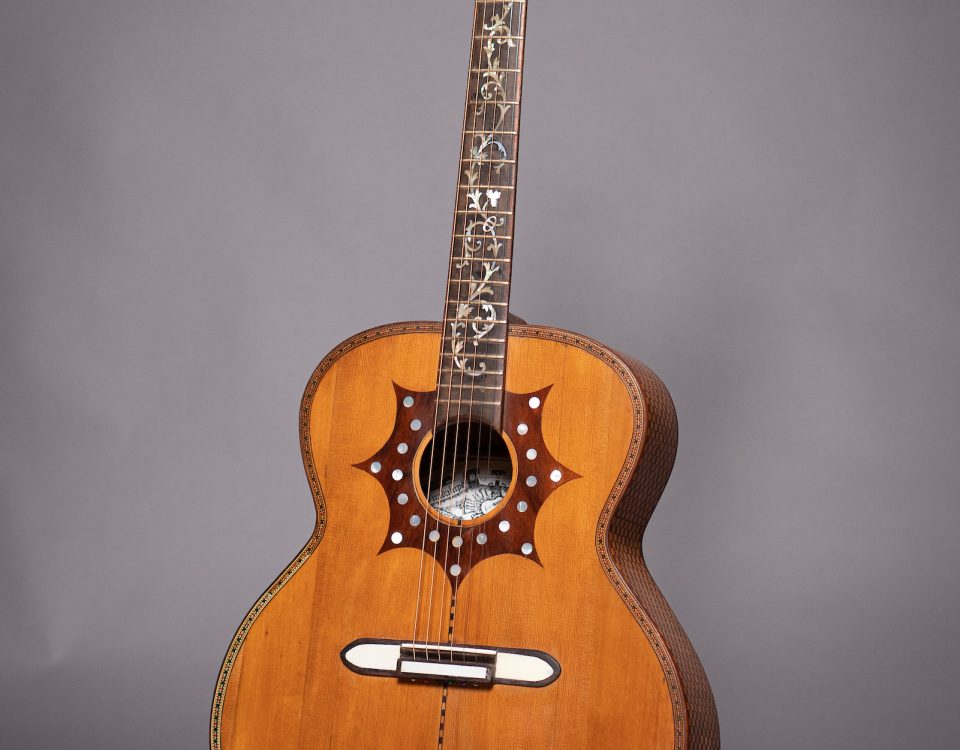
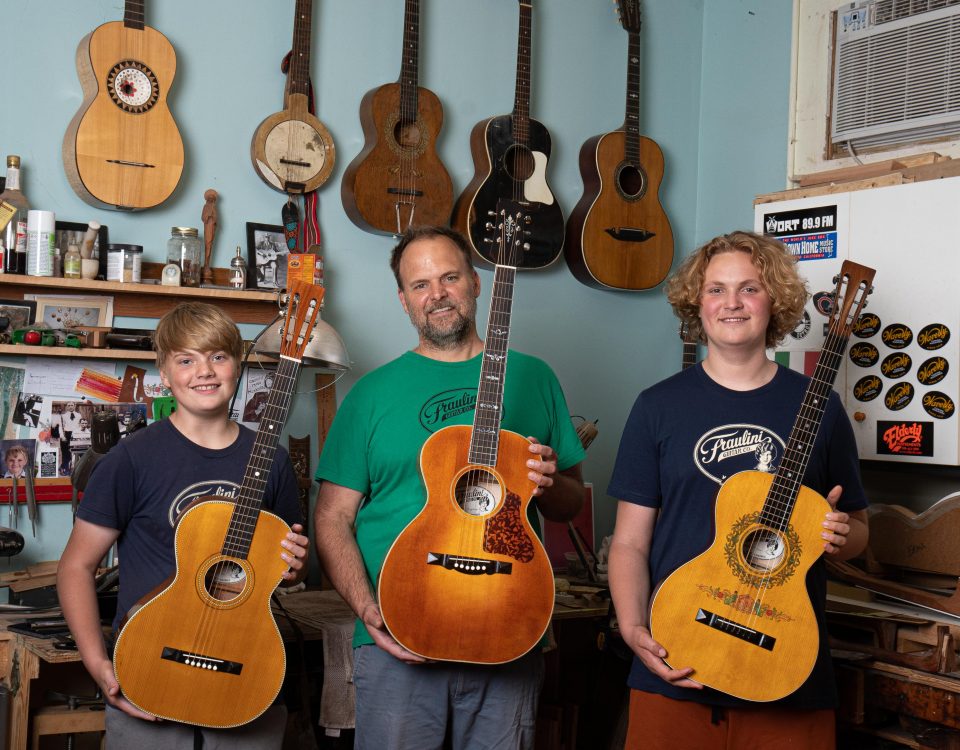
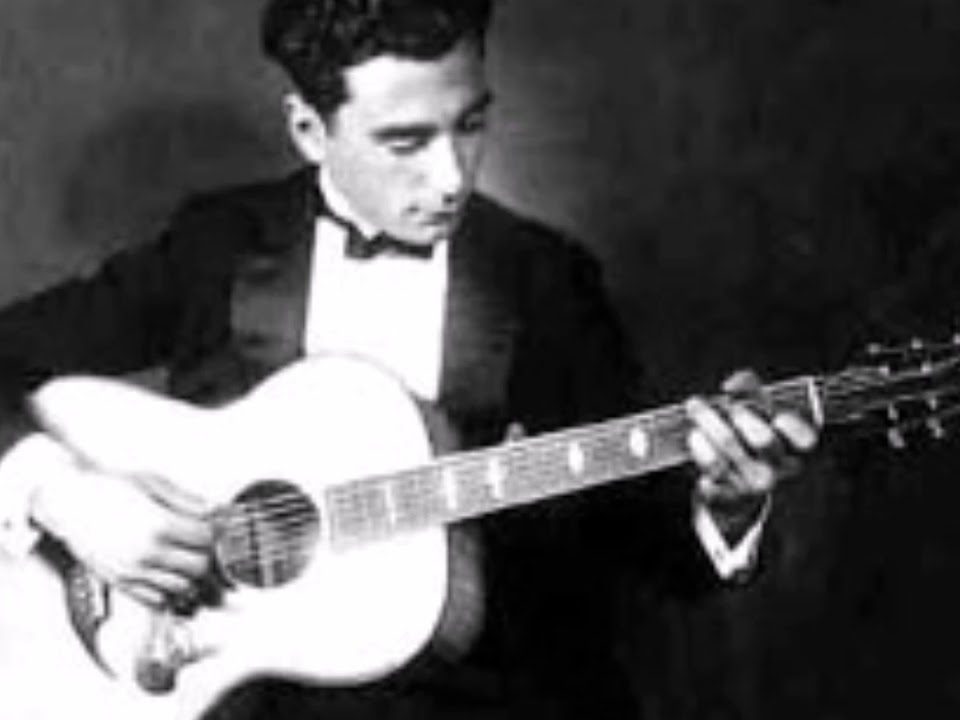
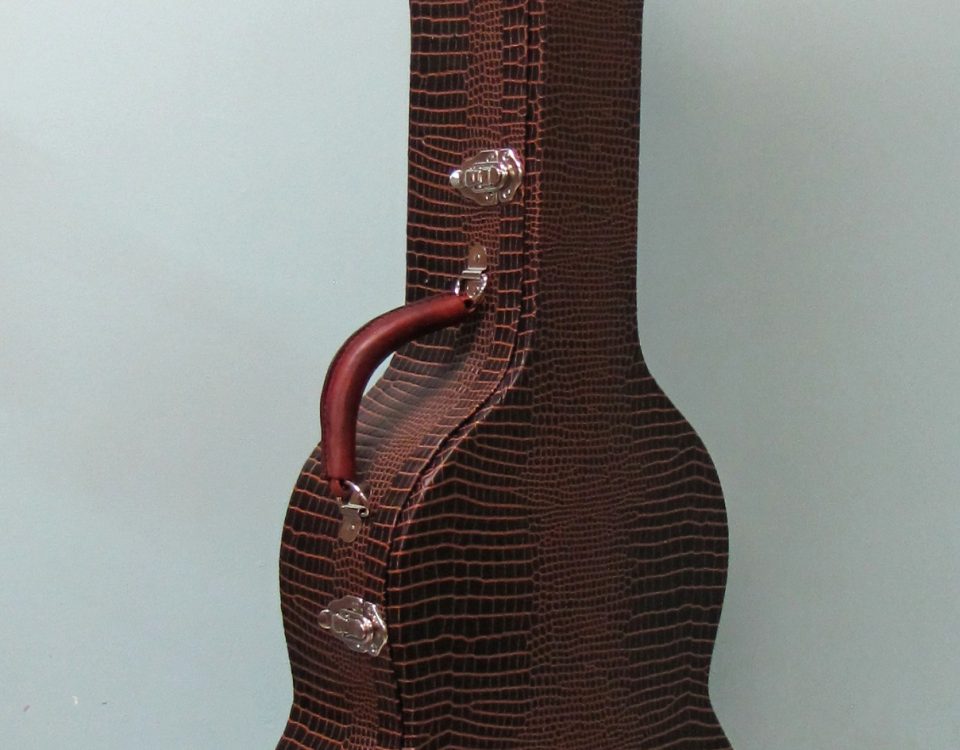

2 Comments
TODD:
Wow, wow and more wow.
Thanks Larry. That means a lot coming from you!